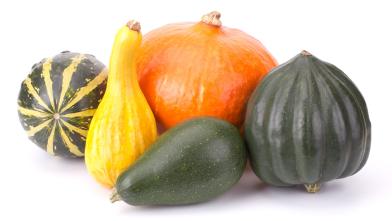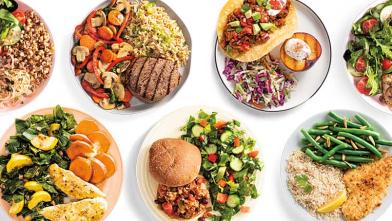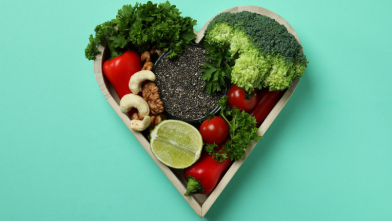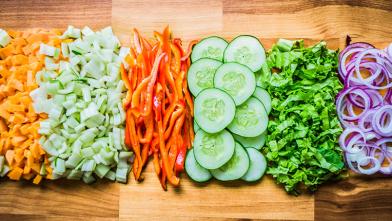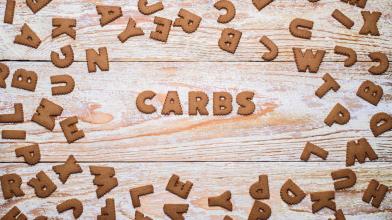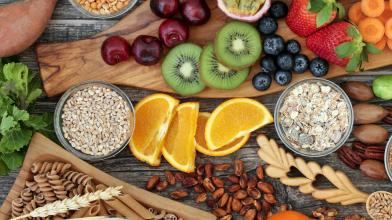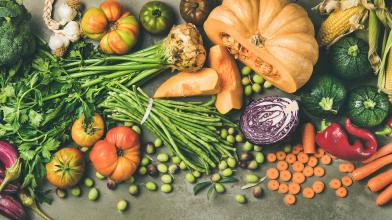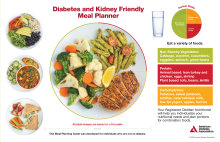
Foods that Fit in Your Eating Plan
Eating foods that have vitamins, minerals, and other nutrients and are minimally processed will help you reach your health goals. Foods like whole grains, vegetables, fruits, lean poultry, seafood, plant proteins, heart-healthy fats, and low-fat dairy have lots of nutrients with fewer calories. Eating these types of food will help you keep your kidneys healthy, manage diabetes, and lower your risk for other health problems. If you have CKD, you may need to limit foods with potassium and phosphorus—talk to your doctor or registered dietitian nutritionist (RDN) to find out.
Eating minimally processed foods also helps lower the amount of sodium you eat each day and stay within recommended levels. If you’re eating packaged food, choose foods that are labeled as low-sodium, no-added salt, or no-added-sugar. Your health care team will let you know if you need to limit your intake of certain foods to keep your nutrient levels within normal limits.
If you need to manage your phosphorus and potassium intake, you can work with your registered dietitian nutritionist to help you adjust your eating plan. The first step is to avoid be cautious of highly processed foods that have phosphorus and/or potassium additives by looking at the ingredient list and looking at the potassium and phosphorus levels written on the nutrition facts label. These can add significant amounts of phosphorus and potassium to your diet. Naturally occurring foods with potassium and phosphorus also need to be monitored. However, understanding some fruits, vegetables, meats, dairy, nuts and legumes can have higher levels, but our body absorbs these nutrients differently. By making changes to your eating plan, you can still enjoy a variety of foods while working toward your health goals.
Using a Diabetes- and Kidney-Friendly Meal Planner

One effective tool for planning meals is the diabetes- and kidney-friendly meal planner, which helps you plan meals with balanced portions for a nourishing eating pan. Here’s how to use it.
Start with a 9-inch plate.
Half Your Plate with Non-Starchy Vegetables
Fill half your plate with non-starchy vegetables. For those with CKD who need to limit their intake of phosphorus and potassium, choose options that have essential vitamins, minerals, and fiber. Examples include:
- Broccoli
- Cauliflower
- Spinach
- Asparagus
- Bell peppers
- Green beans
One Quarter of Your Plate with Starchy Vegetables and Grains
In one fourth of your plate, add starchy vegetables or grains. Starchy vegetables and grains will affect your blood glucose most but provide you with energy and nutrients. Choose whole grains when you can to be able to get more fiber in your meals. Examples include:
- Quinoa
- Brown rice
- Whole wheat bread
- Barley
- Corn
One Quarter of Your Plate with Lean Protein
The last one fourth of the plate, add proteins. Choose lean animal-based and plant-based proteins for lower calories and fats. Eating the right amount of protein in your meals is part of managing CKD. By eating the right amount of protein, you can help keep your kidneys from working too hard after meals.
Plant-based proteins have been shown to reduce health complications and support kidney health. Including a variety of protein sources in your eating plan will help you get essential amino acids
Examples of lean proteins include:
- Lentils
- Beans
- Tofu
- Lean, skinless poultry (such as chicken or turkey breast)
- Fish and shellfish
- Eggs
Heart-Healthy Fats
Eating heart-healthy fats and limiting saturated fats helps with kidney and heart health. Aim to include omega-3 fatty acids and monounsaturated fats in your meals. Examples of healthy fats include:
- Olive oil
- Avocados or avocado oil
- Canola oil
- Nuts
- Seeds
- Fatty fish like salmon, mackerel, and albacore tuna
Focus on Fluids
While water should be your first choice to drink, you can also drink no-calorie options. Some examples are flavored water, unsweetened coffee, unsweetened tea, or zero-calorie clear (not dark) carbonated drinks.
The Takeaway
Having diabetes and kidney-friendly eating plan will help you manage diabetes and CKD. By using the diabetes- and kidney-friendly meal planner,, you can create balanced, nourishing meals that support your health. You can also talk with your registered dietitian nutritionist (RDN) to create an eating plan built for your specific needs and goals.
For more resources on diabetes and kidney disease visit diabetes.org/kidney.

This article is brought to you by DaVita, National Sponsor of Living with Diabetes.







